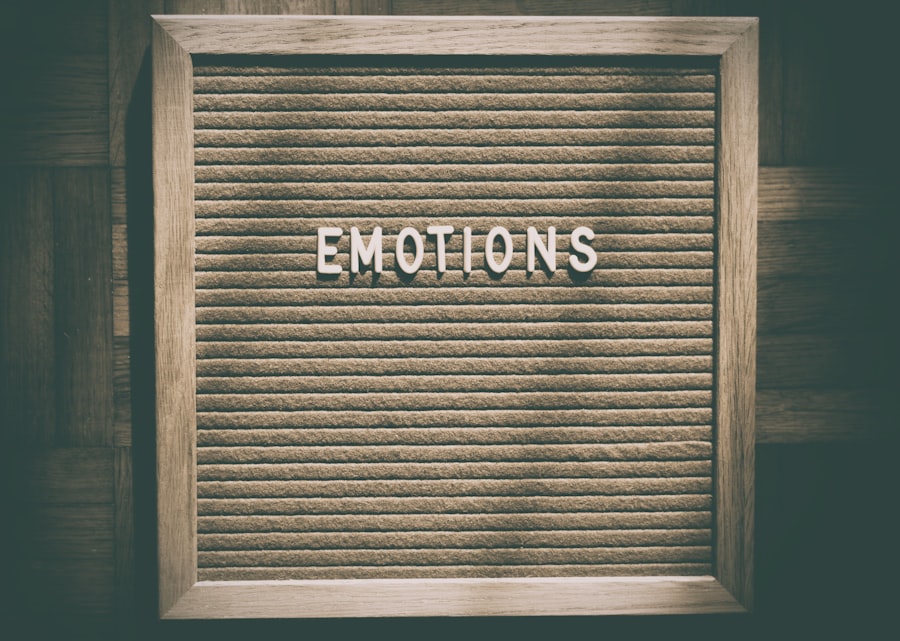Pain and difficult emotions are universal experiences that everyone encounters at some point in their lives. You may find that pain manifests in various forms, whether it be physical discomfort, emotional turmoil, or psychological distress. Understanding the nature of these feelings is crucial for navigating through them.
Pain often serves as a signal, alerting you to something that needs attention, whether it’s a physical injury or an emotional wound. Recognizing that pain is not merely a negative experience but a vital part of the human condition can help you approach it with a more open mindset. Difficult emotions, such as sadness, anger, or fear, can feel overwhelming and isolating.
You might struggle to comprehend why these feelings arise or how to cope with them effectively. It’s essential to acknowledge that these emotions are not inherently bad; they are simply part of your emotional landscape.
Instead of viewing them as obstacles, consider them as opportunities for growth and self-discovery.
Key Takeaways
- Pain and difficult emotions are a natural part of the human experience and should be understood and acknowledged.
- Embracing pain is important for personal growth and transformation, as it allows for the processing and integration of difficult emotions.
- Allowing difficult emotions to surface without judgment or resistance is a crucial step in the healing process.
- Learning to sit with discomfort and pain can help build resilience and emotional strength.
- Cultivating compassion and self-kindness is essential for navigating and processing pain in a healthy way.
Recognizing the Importance of Embracing Pain
Embracing pain is a transformative practice that can lead to profound personal growth. When you allow yourself to fully experience pain rather than suppressing or avoiding it, you open the door to deeper understanding and healing. This process may feel uncomfortable at first, but it is essential for your emotional well-being.
By acknowledging your pain, you validate your experiences and give yourself permission to feel. This act of acceptance can be liberating, allowing you to move forward rather than remain stuck in a cycle of avoidance. Moreover, embracing pain can foster resilience.
When you confront your difficult emotions head-on, you develop coping strategies that can serve you well in the future. You may discover strengths within yourself that you never knew existed. This newfound resilience can empower you to face life’s challenges with greater confidence and grace.
By recognizing the importance of embracing pain, you take the first step toward transforming your relationship with your emotions and ultimately enhancing your quality of life.
Accepting and Allowing Difficult Emotions to Surface

Acceptance is a powerful tool in managing difficult emotions. You may find that resisting or denying your feelings only intensifies them, leading to a cycle of emotional distress. Instead, practice allowing these emotions to surface without judgment.
This means giving yourself permission to feel sad, angry, or anxious without labeling those feelings as “bad” or “wrong.” Acceptance involves acknowledging your emotions as valid responses to your experiences, which can be incredibly liberating. Allowing difficult emotions to surface also means creating space for them in your life. You might consider setting aside time for reflection or journaling, where you can explore your feelings without interruption.
This practice can help you gain clarity about what you’re experiencing and why. By accepting and allowing your emotions to surface, you create an opportunity for healing and growth. You may find that as you embrace these feelings, they begin to lose their power over you, allowing you to move forward with greater ease.
Learning to Sit with Discomfort and Pain
| Metrics | Data |
|---|---|
| Number of participants | 50 |
| Duration of practice | 30 minutes |
| Level of discomfort (1-10) | 6 |
| Improvement in sitting time | 20% |
Sitting with discomfort and pain is an essential skill that can enhance your emotional resilience. It may feel counterintuitive to remain present with feelings of discomfort; however, this practice can lead to profound insights about yourself and your experiences. When you sit with pain rather than trying to escape it, you cultivate a deeper understanding of its origins and implications.
This process requires patience and self-compassion, as it can be challenging to remain present with uncomfortable feelings. You might find it helpful to create a safe space for this practice. Whether through meditation, deep breathing exercises, or simply sitting quietly with your thoughts, allow yourself the time and space to explore your discomfort.
As you learn to sit with pain, you may discover that it becomes more manageable over time. Instead of feeling overwhelmed by your emotions, you can observe them with curiosity and compassion. This shift in perspective can empower you to navigate future challenges with greater ease and confidence.
Cultivating Compassion and Self-Kindness in the Face of Pain
Compassion and self-kindness are vital components of navigating pain and difficult emotions. When faced with emotional distress, it’s easy to fall into patterns of self-criticism or judgment. However, practicing self-compassion allows you to treat yourself with the same kindness and understanding that you would offer a friend in a similar situation.
This shift in mindset can be transformative, helping you cultivate a more nurturing relationship with yourself. To cultivate compassion in the face of pain, start by acknowledging your suffering without judgment. Remind yourself that it’s okay to feel what you’re feeling; everyone experiences pain at some point in their lives.
You might also consider engaging in positive self-talk or affirmations that reinforce your worthiness and resilience. By fostering an attitude of self-kindness, you create a supportive internal environment that encourages healing and growth.
Utilizing Mindfulness and Meditation to Navigate Difficult Emotions
Mindfulness and meditation are powerful tools for navigating difficult emotions and pain. These practices encourage you to remain present in the moment, allowing you to observe your thoughts and feelings without becoming overwhelmed by them. When you engage in mindfulness, you cultivate an awareness of your emotional landscape, which can help you identify patterns and triggers associated with your pain.
Incorporating meditation into your daily routine can further enhance this practice. Even just a few minutes of focused breathing or guided meditation can create a sense of calm amidst emotional turmoil. As you develop a mindfulness practice, you may find that your ability to sit with discomfort improves significantly.
This newfound awareness allows you to respond to difficult emotions with greater clarity and intention rather than reacting impulsively out of fear or anxiety.
Finding Healthy Outlets for Expressing and Processing Pain
Finding healthy outlets for expressing and processing pain is crucial for emotional well-being. You may discover that creative activities such as writing, painting, or playing music provide an effective means of channeling your emotions. These outlets allow you to externalize what you’re feeling, transforming internal turmoil into something tangible and expressive.
Engaging in creative pursuits can also serve as a form of catharsis, helping you release pent-up emotions in a constructive way. Physical activity is another excellent outlet for processing pain. Whether through exercise, yoga, or simply going for a walk in nature, movement can help release endorphins and alleviate emotional distress.
You might find that engaging in physical activities not only improves your mood but also provides clarity as you navigate through difficult emotions. By finding healthy outlets for expression, you empower yourself to process pain in ways that promote healing rather than further suffering.
Seeking Support and Connection in Times of Emotional Distress
During times of emotional distress, seeking support from others is essential for healing. You may feel tempted to isolate yourself when experiencing pain; however, reaching out for connection can provide comfort and understanding. Sharing your feelings with trusted friends or family members allows you to feel less alone in your struggles.
They may offer valuable perspectives or simply lend a listening ear, which can be incredibly validating. Additionally, consider seeking professional support if needed. Therapists or counselors can provide guidance tailored specifically to your experiences and help you develop coping strategies for managing difficult emotions.
Engaging in support groups or community activities can also foster connection with others who share similar experiences. By seeking support during challenging times, you create a network of understanding that can significantly enhance your emotional resilience.
Embracing Pain as a Catalyst for Growth and Transformation
Embracing pain as a catalyst for growth is a powerful mindset shift that can transform how you view your experiences. Rather than seeing pain solely as something negative, consider how it can lead to personal development and transformation.
When you embrace pain as an opportunity for growth, you begin to reframe your narrative around suffering. Instead of feeling defeated by difficult emotions, recognize them as stepping stones on your journey toward self-discovery and healing. This perspective allows you to approach challenges with curiosity rather than fear, empowering you to navigate life’s ups and downs with greater confidence.
Integrating Difficult Emotions into a Balanced and Fulfilling Life
Integrating difficult emotions into a balanced life involves recognizing their place within the broader context of your experiences. You may find that acknowledging these feelings allows them to coexist alongside joy and fulfillment rather than overshadowing them entirely. By accepting that difficult emotions are part of the human experience, you create space for a more nuanced understanding of what it means to live fully.
Consider developing practices that promote emotional balance in your life. This could include setting aside time for self-care activities that nourish your spirit or engaging in hobbies that bring you joy. By intentionally creating space for both difficult emotions and positive experiences, you cultivate a more holistic approach to living—a life where all feelings are acknowledged and valued.
Embracing the Impermanence of Pain and Difficult Emotions
Finally, embracing the impermanence of pain and difficult emotions is essential for fostering resilience and acceptance. You may find comfort in recognizing that all feelings are transient; just as joy comes and goes, so too do moments of sadness or discomfort. Understanding this impermanence allows you to approach difficult emotions with greater ease—knowing that they will eventually pass.
This perspective encourages mindfulness in how you experience pain; instead of clinging to it or resisting it, allow yourself to observe it without attachment. By embracing the ebb and flow of emotions, you cultivate a sense of peace amidst life’s inevitable ups and downs. Ultimately, recognizing the impermanence of pain empowers you to navigate your emotional landscape with grace and resilience—transforming challenges into opportunities for growth along the way.
Integrating painful emotions can be a challenging yet transformative process. For those seeking guidance on this journey, a valuable resource is the article available on Unplugged Psych, which offers insights and strategies for effectively managing and embracing difficult feelings. You can read more about it in their article [here](https://www.unpluggedpsych.com/).
WATCH THIS! Spiritual Bypassing Is Your Brains Favorite Lie
FAQs
What are painful emotions?
Painful emotions are feelings such as sadness, anger, fear, and shame that can cause discomfort and distress. These emotions can be triggered by various experiences and can have a significant impact on an individual’s well-being.
Why is it important to integrate painful emotions?
Integrating painful emotions is important for emotional well-being and personal growth. Avoiding or suppressing these emotions can lead to long-term negative effects on mental health and overall quality of life. By integrating painful emotions, individuals can develop healthier coping mechanisms and gain a better understanding of themselves.
What are some strategies for integrating painful emotions?
Some strategies for integrating painful emotions include mindfulness practices, seeking support from a therapist or counselor, journaling, and engaging in self-care activities. It’s important to acknowledge and validate these emotions rather than trying to push them away.
How can mindfulness help with integrating painful emotions?
Mindfulness can help individuals become more aware of their painful emotions without judgment. By practicing mindfulness, individuals can learn to observe their emotions without becoming overwhelmed by them, leading to a greater sense of acceptance and self-compassion.
When should someone seek professional help for integrating painful emotions?
If painful emotions are significantly impacting an individual’s daily functioning, relationships, or overall well-being, it may be beneficial to seek professional help. A mental health professional can provide guidance and support in developing healthy coping strategies and processing painful emotions.




